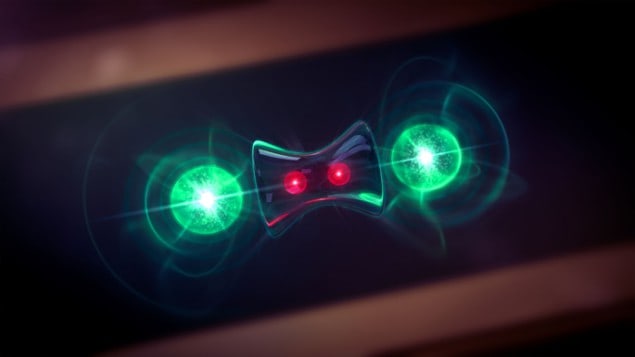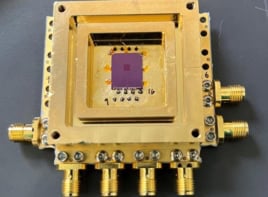
An entangled state of two quantum bits (qubits) can be created and stabilized using interactions that are normally thought to be detrimental, according to two international groups of researchers. While the groups studied two different physical systems, they have both shown that an entangled quantum system can be produced and maintained by coupling it to an environment that dissipates energy.
External noise
Entanglement is a purely quantum-mechanical phenomenon and that plays a crucial role in quantum-information systems. It allows two particles, such as photons or electrons, to have a much closer relationship than predicted by classical physics, and it is this relationship that could be exploited in quantum computers and cryptography. Physicists are keen to create and maintain entangled states in a variety of quantum systems, but a common problem that arises while creating these states is decoherence – the destruction of entanglement that occurs when a quantum system interacts with its surroundings. To avoid this, researchers try to keep an entangled system completely isolated from its environment – a difficult task.
But in recent years, new theoretical work has shown that the dissipative interactions with the environment could instead be used to preserve coherence, and the method has already been used to stabilize the state of a single qubit. Now though, the two research groups have gone one step further by actually using dissipation to create and sustain an entangled state in two different systems – one team uses ions, while the other uses superconducting qubits.
Anders Sørensen and Florentin Reiter at the University of Copenhagen, along with Nobel laureate David Wineland, John Gaebler, and colleagues at the National Institute of Standards and Technology (NIST) in the US produced a stable entangled state between two trapped beryllium ions. They used a set of tailored interactions including “sympathetic cooling” by two magnesium ions in the same trap.
Excited states
The ions’ spins were entangled using two ultraviolet laser beams and induced to “leak” any “unwanted” quantum states to the environment through continuous application of microwaves and one laser beam. “The simple explanation is that it is similar to so-called optical pumping. The two qubits can be in four different states and one of them is the entangled state that we want,” explains Sørensen. “If they are in any of the three undesired states, a laser puts them to an excited state from which they decay down again.” This excitation is done until all the qubits end up in the desired state, where carefully chosen interactions and resonance conditions ensure that the excitation out of the state is suppressed.

The researchers found that after 12 ms, the spins were still highly entangled. “In principle, you can prepare a dissipative state where you are truly in a steady state so that the lifetime is as long as you wish,” says Sørensen. This was almost the case in the team’s experiment, but there is a small leak that the researchers do not correct. The team estimates that the lifetime of the entanglement is closer to 84 ms, which is very long compared with any other timescale in the experiment. The qubits approached the target state within a few milliseconds and were found to be in the correct entangled state 75% of the time. By applying about 30 repetitions of their excitation technique, the scientists boosted the success rate to 89% in a separate experiment.
According to Sørensen, the team purposefully designed its system so that it could be scaled up to include more atoms – something that could allow quantum computation. The researchers current experiment also let them investigate whether the method of allowing the system to talk to the environment actually represents an advantage for such real experiments.
Sørensen admits that, for now, the dissipative processes tend to be a bit slower than the more commonly used quantum gate – the basic building block of a quantum circuit that operates on a small number of qubits – but not necessarily much slower. He told physicsworld.com that one benefit of the new dissipative-state preparation is that the researchers can “now really begin to investigate whether there is an advantage of using dissipation as compared to gates. For the concrete system that we used, you probably could have done better with gates, but we can see that there are other scenarios such as optical cavities or if you have fluctuating lasers where using dissipation really helps.”
Feedback loops
The other team to achieve entanglement using dissipation included Shyam Shankar and Michel Devoret at Yale University, along with other colleagues. Their qubits are superconducting circuits, used along with a microwave cavity that serves as the dissipative reservoir. Shankar explains that, normally, a measurement-based feedback system is used to create entanglement. That involves first measuring the state of the qubit system with high fidelity, then using real-time electronics to determine whether the system is in the desired state or not. If it is not, a control drive would be applied to the system to bring it back to the desired state. Instead, the team uses an “autonomous” feedback scheme that does not require a measurement process to maintain coherence. The researchers apply six continuous drives (tones at carefully chosen microwave frequencies) combined with a specifically engineered coupling between the qubits and the dissipative reservoir. The researchers have engineered their system such that, in the presence of these drives, the ground state of the effective driven system is an entangled state.
Quantum building blocks
The fidelity of the entanglement is determined by the ratio of the feedback rate to the error rate. Currently, the researchers’ entangled state was maintained with an average fidelity of 67%, for a maximum of 500 μs. “This time is essentially indefinite…we could have taken the data for a longer time if we wanted to. The entangled state that we stabilize is, of course, a building block to make more complicated multi-qubit entangled states that are required for quantum-information processing,” says Shankar, further explaining that this method could allow for a “fully error-corrected logical qubits to be developed in the future”.
“Our autonomous method using dissipation eliminates this external feedback loop and is thus simpler to implement,” says Shankar. “We also do not have to worry about the latency of an external loop; in fact, the intrinsic dissipation of the system can correct the errors faster than any external loop could.” But he also points out that such an autonomous-feedback strategy has to be tailored to the particular system used and the particular state one is trying to stabilize, making it difficult to create any kind of general protocol.
In the coming months, Shankar’s team plans to combine the autonomous approach along with an external measurement-based feedback loop to get the best of both worlds. “The simplicity and quick response of autonomous feedback with the flexibility and reliability of measurement-based feedback,” says Shankar. On the other hand, Sørensen and colleagues are looking at extending their method to multi-particle entanglement so that they can see just how well and how many qubits they can entangle.
Sørensen and Shankar’s papers are published in Nature.


